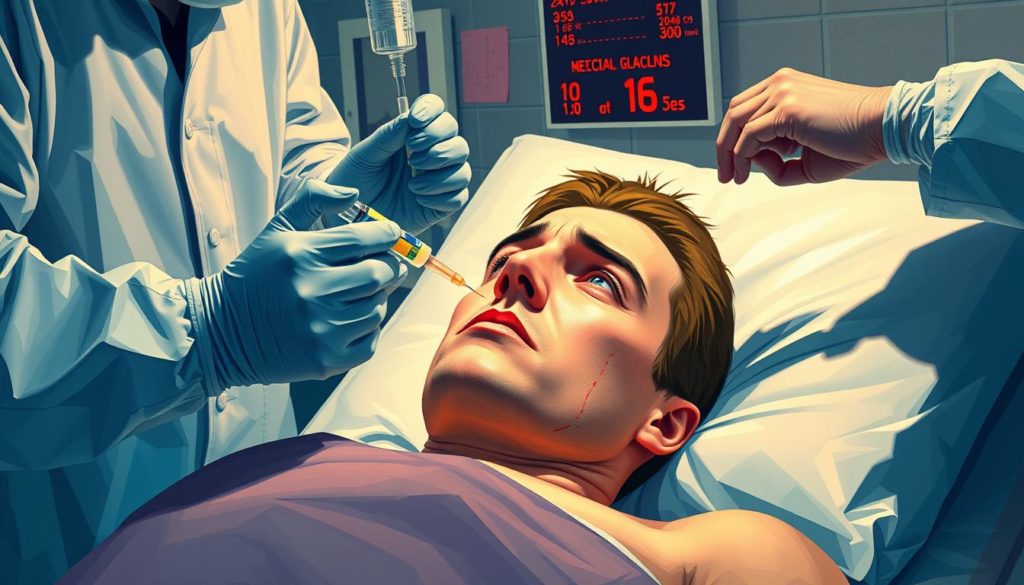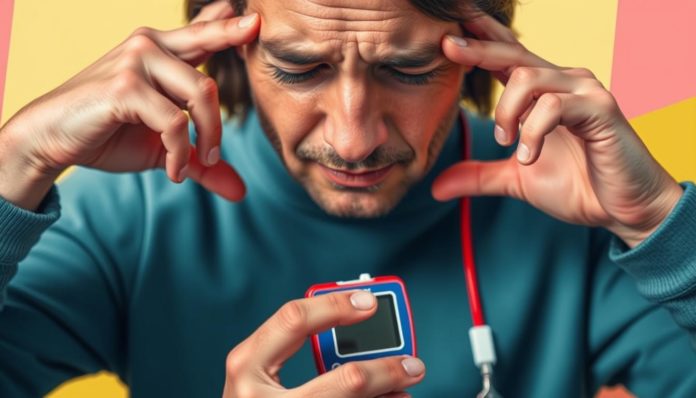About 12% of people with diabetes have at least one severe hypoglycemia episode every year. This diabetes emergency sign may lead to serious health issues, like comas or death.
Diabetic shock, or insulin shock, happens due to insulin level imbalances. Knowing the early hypoglycemia symptoms and managing low blood sugar quickly is key to avoiding a diabetic crisis.
Being informed and proactive is important. When you understand how insulin and blood sugar changes affect you, you can steer clear of diabetic shock.
What is Diabetic Shock?
Diabetic shock, also known as insulin shock or severe hypoglycemia, happens when blood sugar drops very low. This can happen quickly and become an emergency without fast treatment.

Definition and Overview
Diabetic shock is not just a small drop in blood sugar; it’s a major problem that needs quick medical help. While insulin shock makes blood sugar fall fast, symptoms might include shaking and sweating. More severe symptoms can be losing consciousness or having seizures.
Differences between Hypoglycemia and Diabetic Shock
It’s important to know the differences between hypoglycemia and insulin shock. Mild hypoglycemia might give you a headache, dizziness, or anxiety and can often be fixed with some quick sugar. But diabetic shock can make blood sugar swing wildly, causing very serious issues like convulsions or even a coma. Fast treatment is needed to take care of diabetic shock.
Causes of Insulin Reactions
Understanding why insulin reactions happen is key to preventing them. It’s also vital for managing blood sugar. There are several things that can cause these reactions. That’s why staying alert and informed is necessary.
Excessive Insulin Intake
Taking too much insulin is a common cause of these reactions. This can result in insulin overdose effects like severe hypoglycemia. Always stick to the dosage your doctor gives you. It’s important to talk to them before making changes.
Skipping Meals
Not eating can mess up your blood sugar and raise your risk of insulin reactions. If you take insulin without eating enough carbs, you might get hypoglycemia. Eating regularly is key to avoiding these reactions.
Unusual Physical Activity
Exercise that’s unexpected or intense can trigger insulin reactions. Working out makes your body more sensitive to insulin. This could lower your blood sugar if you don’t adjust your insulin or carbs.

- Excessive Insulin Intake: Watch your doses closely to steer clear of insulin overdose effects.
- Skipping Meals: Eat regularly to keep your blood sugar stable.
- Unusual Physical Activity: Change your insulin or carb intake based on how much you exercise.
| Cause | Impact | Prevention |
|---|---|---|
| Excessive Insulin Intake | Hypoglycemia | Follow prescribed doses, consult healthcare provider |
| Skipping Meals | Blood sugar drops | Maintain regular meal schedule |
| Unusual Physical Activity | Increased insulin sensitivity | Adjust insulin/carbohydrate intake |
Common Symptoms of Hypoglycemia
It’s very important to know if your blood sugar is low. This helps manage diabetes and stops bad complications. Hypoglycemia shows up in different ways, which we need to quickly recognize and handle.
Early Symptoms
The first signs of low blood sugar are not always clear but are important. You might feel dizzy, hungry, or start to shake and sweat. Feeling moody, having a fast heartbeat, and feeling anxious are also early signs. Knowing these can help you correct your blood sugar fast.
Severe Symptoms
Not dealing with hypoglycemia quickly can cause very bad symptoms. These can be very scary, like getting confused, seeing blurry, having seizures, or fainting. If this happens, it’s very important to get medical help right away to avoid very dangerous problems.
Nighttime Symptoms
Low blood sugar at night is hard to notice because you are sleeping. But there are signs, like crying out, having nightmares, and feeling tired or cranky when you wake up. This means you might have low blood sugar in your sleep and might need to change your night routine to keep your sugar level okay.
| Hypoglycemia Signs | Early Symptoms | Severe Symptoms | Nighttime Symptoms |
|---|---|---|---|
| Recognizing low blood sugar | Dizziness, hunger, sweating | Confusion, seizures, unconsciousness | Crying out, nightmares, waking up tired |
Understanding Your Body’s Blood Sugar Levels
Keeping your blood sugar at the right level is key to managing diabetes well. Blood sugar that goes too high or too low can lead to health issues. It’s important to know what affects your blood sugar.
- Diet: Your diet plays a big role in controlling blood sugar. Eating meals with carbs, proteins, and fats keeps things balanced.
- Physical Activity: Exercise helps balance blood sugar. But, you need to plan it well to avoid sudden changes.
- Medication: Using insulin or diabetes medicine correctly is crucial. It helps prevent dangerous blood sugar levels.
Watching your blood sugar closely helps avoid problems like severe dehydration from high levels. Keeping blood sugar in check also prevents damage to organs over time. Balancing diet, activity, and meds helps keep blood sugar in the target range.
| Time of Day | Blood Sugar Level (mg/dL) |
|---|---|
| Before Meals | 70-130 |
| 1-2 Hours After Meal | Less than 180 |
| Bedtime | 90-150 |
To manage low blood sugar, you need to act quickly. Keeping symptoms under control helps avoid more issues. By watching how your body responds, changing your lifestyle, and following your doctor’s advice, you can control your diabetes.
How to Recognize an Insulin Reaction
Spotting an insulin reaction quickly is crucial. It can turn a simple situation into something serious. Being familiar with emergency signs is key. It helps you stay aware of hypoglycemia.
Personal Symptoms Diary
A symptoms diary is very helpful. It lets you see what triggers your low blood sugar. Since symptoms vary, noting them down aids in fast detection. Common signs include sweating, shaking, and a faster heartbeat.
Monitoring Blood Glucose
Checking your blood sugar regularly is important. It helps you recognize any changes early. Knowing your ideal blood sugar range is part of staying safe. Here’s an easy way to keep track:
| Time of Day | Target Blood Glucose Range (mg/dL) |
|---|---|
| Before Meals | 80-130 |
| 1-2 Hours After Meals | Less than 180 |
| Bedtime | 100-140 |
Knowing diabetes emergency signs is vital. Making hypoglycemia awareness a daily habit helps lower insulin reaction risks.
Immediate Steps to Take During Diabetic Shock
When diabetic shock happens, acting fast is key for safety. The “15-15 Rule” is a known method. It helps treat insulin reactions well.
Using the 15-15 Rule
Start by taking 15 grams of fast carbs, like glucose tablets or juice, at the first low blood sugar sign. After 15 minutes, check your blood sugar again. If it’s still low, do it again. This method quickly balances blood sugar, avoiding serious issues.
When to Seek Emergency Help
If symptoms don’t improve or get worse, seek emergency care right away. Severe insulin reactions might make self-treatment impossible. That’s when calling for emergency services is urgent. Using glucagon injections or intranasal glucagon can be life-saving. Teaching your close ones how to use glucagon is crucial during emergencies.
Preventing Diabetic Shock and Insulin Reactions
To manage diabetes well, you must be proactive. By following key steps, you can cut the risk of diabetic shock.
Regular Monitoring
Checking your blood sugar often is key. Using tools like CGMs catches sugar level issues fast. This helps you react quickly to keep your sugar levels right.
Regular checks help you understand how your body reacts to insulin and food. This makes managing diabetes easier.
Avoiding Skipped Meals
Not skipping meals helps keep blood sugar stable. When you skip meals, your sugar levels can drop dangerously low. This can lead to a serious reaction.
Eating on a regular schedule keeps your body’s sugar levels even. This is very important for diabetes management.
Adjusting Insulin Dosage
It’s important to adjust your insulin based on your day and what you eat. Everyone’s insulin needs are different because of exercise, stress, and food changes.
Making careful changes to your insulin dose prevents too high or too low sugar levels. This way, you avoid dangerous sugar swings.
Diabetic Shock and Insulin Reactions
Diabetic shock and insulin reactions need quick action and clear understanding. It’s key to know the early signs and how to treat them. One method is the “15-15 Rule” which involves eating 15 grams of carbs. Then, after 15 minutes, check the blood sugar to see if it’s above 70 mg/dL.
“Proper treatment protocols and emergency action plans are crucial for avoiding severe hypoglycemia.”
To lower the risk of serious issues, learn about what causes insulin reactions. These reactions can happen for many reasons. Taking too much insulin, not eating enough, or extra exercise can lower blood sugar too much. This might lead to diabetic shock.
Using diabetic crisis management methods every day helps protect against insulin shock. Key steps include:
- Checking your blood sugar often
- Eating regularly to avoid missed meals
- Changing insulin amounts as your doctor says
If a bad insulin reaction happens, it’s vital to have an emergency plan. This plan will guide you and tells others how to help. Making sure your family, friends, or coworkers know what to do is important. They can support you in an emergency.
Let’s compare some key ways to manage low blood sugar well:
| Action | Description | Outcome |
|---|---|---|
| The 15-15 Rule | Consume 15 grams of carbs, then wait 15 minutes before rechecking blood sugar | Stabilizes mild hypoglycemia |
| Emergency Glucagon | Administered when the person is unconscious or unable to eat | Reverses severe hypoglycemia |
| Eating Frequent Small Meals | Prevents drops in blood sugar by maintaining a steady intake | Reduces risk of hypoglycemia |
By blending these tactics with a good grasp of how insulin and blood sugar work, you can manage diabetic crises well. Improve your health by getting to know your body’s insulin and sugar levels. For deep info on insulin reactions and low blood sugar, see this complete guide.
Role of Physical Activity in Blood Sugar Management
Regular physical activity is crucial for managing diabetes well. It not only boosts overall health but also helps keep blood sugar levels just right. Making small changes to insulin and what you eat can make exercise even more effective.
Benefits of Exercise
Exercise has many benefits for people with diabetes. It helps better control blood sugar and makes the body less resistant to insulin. Exercise also helps keep your weight in check, lowers heart disease risk, and gives you more energy.
Balancing Activity and Insulin Dosage
Exercise is great, but it’s important to match it with the right insulin amount to avoid low blood sugar. This is especially vital for those who take insulin or certain medicines. Changing how much insulin you take or what you eat before exercising can help keep sugar levels stable. Working with doctors to create a plan can be the best way to handle exercise’s effects on blood sugar.
Managing Blood Sugar Fluctuations
Dealing with blood sugar highs and lows is a daily task for those with diabetes. Using tools like continuous glucose monitoring helps them stay ahead. They can act quickly before things get out of hand. Knowing what causes these ups and downs is key. It includes when and what you eat, how active you are, and stress levels.
Meal timing and exercise have big roles in blood sugar control. Eating balanced meals regularly stops sudden changes. Also, being active helps, but it’s important to adjust insulin as needed.
Continuous glucose monitors give updates that help make smart choices. They warn about high or low sugar levels and show trends. This info helps avoid too low or too high blood sugar.
To sum up, tackling the different aspects that affect blood sugar and using tools like continuous glucose monitoring improves diabetes care. Making small daily changes and embracing new tech can stabilize blood sugar.
Using Glucagon in Emergencies
During a serious low blood sugar event, knowing about glucagon emergency use is critical. This hormone helps by making the liver increase blood sugar. It’s key in treating low blood sugar that’s very bad.
How Glucagon Works
Glucagon quickly works by getting the liver to make more sugar. This lifts blood sugar levels fast. It’s very helpful in diabetic emergencies when eating sugar isn’t possible.
Administering Glucagon
Using glucagon is simple but must be done right. It comes as a shot or a nose spray. Always follow the glucagon kit’s guide to help someone quickly and correctly.
Training Family and Friends
Teaching your loved ones how to use glucagon lowers risk in emergencies. Have training often so they’re ready to act fast if needed.
- Hold the emergency kit and explain its contents.
- Demonstrate the step-by-step procedure for both injectable and nasal spray glucagon.
- Discuss potential scenarios where they might need to use glucagon.
- Provide hands-on practice with a demonstration kit if available.
Regular training helps people respond faster. This keeps someone with low blood sugar safer.
Long-term Strategies for Managing Diabetes
Managing diabetes well means integrating vital strategies into your life. This helps keep blood glucose stable and maintains overall health. We’ll look at important parts like eating consistently, wearing medical IDs, and using glucose monitors.
Consistent Meal Patterns
Eating at the same times daily helps keep your energy up and sugar levels balanced. Eating balanced meals regularly helps avoid sugar highs and lows. This makes managing diabetes easier.
Using Medical IDs
Wearing a medical ID for diabetics can save your life in emergencies. These IDs give first responders important health info. This ensures you get the right care quickly during a diabetic emergency.
Continuous Glucose Monitoring Systems
Continuous glucose monitors (CGMs) give instant glucose level readings. They help you make better choices about food, medicine, and exercise. Using CGMs can greatly help control diabetes by providing key insights to keep sugar levels stable.
Consulting Your Healthcare Team
Managing diabetes is a team effort, not just an individual one. You need regular check-ins with your diabetes care team. They make sure your insulin, diet, and exercise match your needs. This team work helps you understand your blood sugar levels. It also improves your daily management and prepares you for emergencies like diabetic shock.
Getting to know your healthcare team is key for effective diabetes care. These experts help with all parts of managing the condition. By meeting with them often, you can control your diabetes better. This helps keep your life quality high. You really need a full diabetes care team for long-term health.
Every part of diabetes management is covered by your healthcare team. They help you make sense of your blood sugar and suggest lifestyle changes. They guide you based on your health history and current status. Your care becomes personalized and more effective. Working with this team makes your diabetes easier to handle and improves your health.
FAQ
What is Diabetic Shock?
Diabetic shock, or insulin shock, happens when your sugar levels drop very low. It needs quick action to avoid serious health problems.
What are the early symptoms of hypoglycemia?
Early signs include feeling dizzy, hungry, or sweaty. You might also have a headache, feel anxious, or shake.
How can I manage low blood sugar levels?
Keep a regular check on your blood sugar. Eat meals at the same time daily. Adjust your insulin or snacks when needed.
What are the differences between hypoglycemia and diabetic shock?
Mild hypoglycemia can cause headache and dizziness but you can treat it yourself. Diabetic shock is worse, leading to seizures or blackouts. It needs quick medical help.
What causes insulin reactions and how can I prevent them?
Taking too much insulin, missing meals, or extra exercise can cause reactions. Prevent them by checking your sugar often, managing your insulin, and eating regularly.
What are severe symptoms of hypoglycemia?
Serious symptoms include passing out or having seizures. These need urgent medical attention.
What should I do if I recognize signs of diabetic shock?
Use the “15-15 Rule.” Eat 15 grams of carbs and check your sugar after 15 minutes. Repeat if needed. If it’s bad, get emergency help right away.
How important is it to maintain optimal blood sugar levels?
Keeping your sugar levels right is key. It helps prevent serious problems like diabetic shock and damage to organs. This needs watching your diet, exercise, and medicine closely.
How does physical activity and insulin dosage balance impact blood sugar management?
Exercise helps control your sugar and lessen insulin resistance. It’s important to balance your insulin and carbs with exercise to avoid low sugar.
What is glucagon, and how is it used in emergencies?
Glucagon is a hormone for emergency low sugar. It makes your liver release sugar quickly. You can take it as a shot or nasal spray.
What are the benefits of using continuous glucose monitoring systems?
These systems track your sugar live. They help you make smart choices about food, pills, and exercise. This keeps your sugar in a safe zone.
How can I educate my family and friends about my diabetes and emergency procedures?
Teach them how to use emergency glucagon. Make sure they know symptoms and what to do if your sugar drops too much. This can lower risks in emergencies.
Why is it necessary to have a healthcare team when managing diabetes?
A healthcare team customizes your care. They adjust your insulin, diet, and workout plan. They also help with understanding sugar levels and emergency plans.


